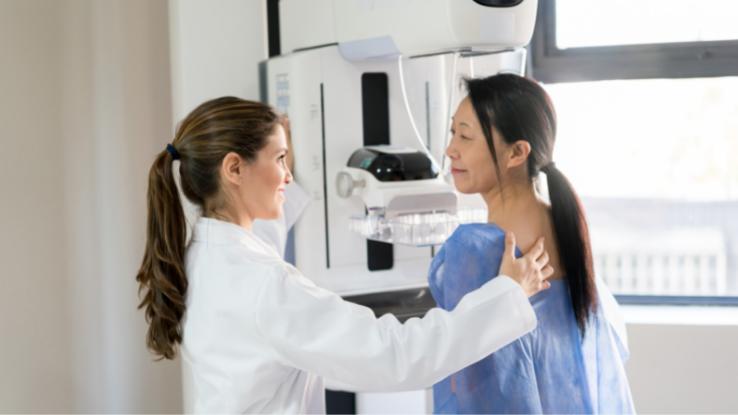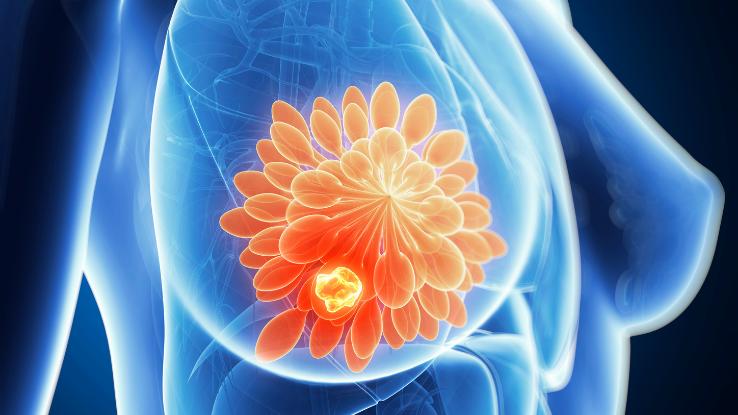What Does Cancer in Beef Look Like
Chest Cancer: Risk Factors, Symptoms & Treatment

When cancerous cancer cells form and abound within a person's chest tissue, breast cancer occurs. Although it is the most commonly diagnosed cancer in American women, breast cancer tin can impact people of all genders. The American Cancer Gild estimates that over 280,000 women and over two,600 men volition be newly diagnosed with invasive chest cancer in 2021 — and about 43,000 women and 530 men volition die from chest cancer.
Here, we'll provide an overview of breast cancer — from the different types to risk factors, symptoms and treatments — to requite you a ameliorate picture of the affliction and its impacts.
Types of Breast Cancer
Chest cancer is a malignancy in which the cells of the breast divide and grow at a faster-than-typical rate and tin can, over time, form tumors in the breast. Without treatment, malignant tumors can spread to other parts of the trunk.
While most breast cancers start in the milk ducts, some malignancies form first in the glandular tissue. Moreover, many tumors grow slowly: information technology may accept as long equally x years for a patient to be able to feel the tumor in their breast. Nevertheless, in some instances, the tumor may exist aggressive and grow at a much faster stride.
What you may not realize is that in that location are dissimilar types of breast cancer. The categorizations refer to the location of the cancer's origin and whether information technology'southward considered invasive or non-invasive. Invasive breast cancer refers to cancer cells that have traveled from their original location and have invaded surrounding tissue; in afterward stages, this blazon of cancer may spread to the lymph nodes or one'south organs. On the other mitt, non-invasive cancers, sometimes referred to equally "carcinoma in situ," are bars to the bespeak of origin and have not spread to otherwise healthy tissue.
With this in mind, types of breast cancer include:
- Ductal Carcinoma In Situ (DCIS): In this most common class of non-invasive breast cancer, making up around 1 in 5 new diagnoses, malignant cells develop inside the milk ducts and remain in place. Although DCIS is non a life-threatening cancer, information technology can increment your chances of developing invasive cancer later on.
- Lobular Carcinoma In Situ (LCIS): Like DCIS, LCIS remains within its place of origin and is non-life threatening. LCIS occurs when aberrant cells have developed in the milk-producing glands. LCIS is not thought of as a truthful grade of breast cancer, but an instance of LCIS tin can put you lot at a higher take a chance for developing chest cancer in the hereafter
- Invasive Ductal Carcinoma (IDC): This grade of cancer, sometimes referred to as infiltrating ductal carcinoma, is the about common form of invasive chest cancer, affecting nearly 80% of all patients with invasive breast cancer. IDC begins in the milk ducts only, somewhen, the cancer cells will pause through the duct walls and attack the surrounding tissue.
- Invasive Lobular Carcinoma (ILC): ILC is the 2d-nigh common class of invasive breast cancer. In an instance of ILC, the cancer cells originate in the milk-producing glands, or lobules, and spread into nearby healthy tissue.
Other rare types of chest cancer include inflammatory chest cancer, angiosarcoma and Paget's disease.
Symptoms Associated With Breast Cancer
In well-nigh cases, folks with early-stage breast cancer won't exhibit signs or symptoms. In fact, cancer is often commencement detected past a routine mammography. Even so, symptoms of breast cancer may include:
- A lump or mass felt in the breast
- An area of thickened tissue in the breast
- A modify in the size of shape of your breast
- Swelling in or around the chest
- Irritation of the skin of the breast
- Dimpling of the skin of the chest
- Rashes on the breast
- Hurting in the chest or nipple area
- Changes in the appearance of the nipple or surrounding skin.
- Discharge from the nipple
- Lump in the underarm area
Changes to the breast or surrounding expanse may be related to other medical conditions. Any unusual changes should be brought to your doctor'due south attending immediately.
Diagnosis & Investigations
Diagnosis of chest cancer involves a physical exam past a md; employ of imaging; and, oftentimes, a biopsy of the abnormal tissue. And so, what are the specifics associated with these procedures?
Imaging
- Mammogram: This procedure uses small amounts of ten-ray beams to visualize the breast tissue.
- Ultrasound: This procedure uses a modest probe placed on the skin of the chest to meet the underlying tissue. Ultrasound may exist more suitable for younger women with breast lumps
Tissue Sampling
- Needle Aspiration: A pocket-sized needle is used to take a sample of the aberrant chest cells, or if fluid is present (a cyst), a sample of fluid may be taken
- Needle Biopsy: A modest core of tissue is removed with a needle, this allows for visualization of the cells
Further Tests
- Computed Tomography (CT) Browse: May be used to encounter if at that place is evidence of spread of breast cancer elsewhere in the body.
- Breast Ten-Ray: Used to await specifically at the lungs to see if there is whatever evidence of spread.
- Blood Tests: Used to check your blood counts, liver role, kidney part and sometimes to perform genetic testing.

Staging
When diagnosing breast cancer, your physician will try to make up one's mind its stage. Staging usually uses the TNM organization which takes into account the size of the tumor (T), if it has spread to whatever lymph nodes (N) and if it has metastasized (M).
Tumour Size (T)
- T0 = main tumor cannot be seen
- T1 = tumor is ≤ 20mm
- T2 = tumor is > 20mm but ≤ 50mm
- T3 = tumor is > 50mm
- T4 = tumor of any size which extends to the chest wall or skin
Nodes
- N0 = no evidence of spread to lymph nodes
- N1 = metastases to due east.thousand. i–3 axillary lymph nodes
- N2 = metastases to e.thou. four–9 axillary lymph nodes
- N3 = metastases to e.g. ≥ 10 axillary lymph nodes or to infraclavicular lymph nodes
Metastasis
- M0 = no testify of distant metastasis
- M1 = evidence of distant metastasis
Other factors, such as which receptors your type of cancer has on its cells, is also usually included in this conception. Those other factors include:
- Homo epidermal growth factor-2 (HER2)
- Estrogen (ER)
- Progesterone (PR)
These parameters are often combined to give an overall "phase" of the cancer:
- Stage 1: The tumor is pocket-size (
- Stage 2: The tumor measures 2–5cm, and there is testify of nearby lymph nodes beingness affected, withal there is no signs of spread to other places in the body
- Stage 3: The tumor measures ii–5cm and in that location is evidence that nearby lymph nodes and nearby structures are afflicted, only there is no sign of distant spread
- Stage four: The cancer has spread to other parts in the trunk.
Note: This is not an exhaustive list of staging parameters as these can be much more complicated.
Grading
Grading of chest cancer is a measure of how "normal looking" the cells are at the time of exam. These grades include:
- G1 = low histological form (favorable)
- G2 = intermediate histological form (moderately favorable)
- G3 = high histological grade (unfavorable)
Note: Low-class cells look more normal than high-grade cells.
Screening & Detection
Screening tests have the ability to find cancer early — when it's most responsive to treatment. Every bit such, people should perform cocky-chest exams and report any changes to their dr..
Moreover, a baseline mammogram is recommended for all women at 40 years old; between the ages of 40 to 49, experts recommend that women schedule mammograms every 1 to 2 years based upon earlier results, gamble factors, and and so on. If whatever abnormalities are nowadays, your doctor may transport you for further testing to either diagnose or rule out cancer.
Causes & Risk Factors
In that location is no definitive crusade for breast cancer, just many hazard factors are associated with the illness, including:
- Having a family unit history of breast cancer (due east.g. in your mother, sister or aunt)
- Increasing age
- Being overweight or obese
- Maintaining an unhealthy nutrition or lifestyle
- Early menstruation or late menopause
- The apply of some types of nativity control pills for more than than 10 years
- Radiation to the chest to care for another condition at an early age
- Using hormone replacement therapy
- Smoking

Breast Cancer Treatment
At that place take been incredible advancements made in the handling of breast cancer. As a result, the rate of deaths due to chest cancer has been on the pass up. Handling options may include surgery, radiation, chemotherapy and hormonal therapy. Moreover, your treatment plan will depend on the type and stage of breast cancer you accept, as well equally your medical history and personal preference.
- Surgery: Surgical options include a lumpectomy, which removes only the malignant tissue and leaves the breast looking normal, and/or a mastectomy, in which the entire breast is removed. Mastectomy and lumpectomy may or may not be used in conjunction with other treatments, such as radiation.
- Radiations: The procedure of using loftier force x-rays aimed directly at the cancer cells to kill them.
- Chemotherapy: This procedure uses drugs to deteriorate or kill cancer cells. Hormone therapy can only exist used with certain types of breast cancer, those that are hormone receptor positive.
Integrative and Complementary Medicine
Integrative and complementary therapies can be used in conjunction with traditional medical practices to ease symptoms or improve quality of life. While some complementary therapies have been proven effective, no i should ever use this type of therapy in the identify of standard medical therapy. Integrative and complementary therapies include, but are non limited to, herbal supplements, acupuncture, meditation, massage and psychotherapy.
Prognosis
Prognosis depends on the type and stage of breast cancer. Someone diagnosed with either non-invasive or early on-stage invasive breast cancer may have a better survival rate than those diagnosed with belatedly-stage and/or invasive cancer. Undoubtedly, stage iv cancer that has spread to other areas of the body and throughout the lymph nodes has the poorest prognosis.
If you have any additional questions or concerns regarding chest cancer, contact your healthcare professional.
Resources Links:
- "Cancer Statistics: 2021 Estimates: Breast" via American Cancer Order
- "Breast Cancer" via Medline Plus
- "Breast Cancer" via The American Academy of Family Physicians
- "Breast Cancer" via Mayo Clinic
- "Breast Cancer" via American Cancer Society
- "Cess of breast mass" via BMJ All-time Practice
- "Patient Data from the BMJ: Chest Cancer: DCIS" via BMJ Best Practice
- "Breast Cancer" via National Wellness Service (NHS)
- "National Chest and Cervical Cancer Early Detection Programme" via Centers for Disease Control and Prevention (CDC)
- "Breast Cancer" via Centers for Disease Command and Prevention (CDC)
Source: https://www.symptomfind.com/health-conditions/condition-breast-cancer?utm_content=params%3Ao%3D740013%26ad%3DdirN%26qo%3DserpIndex

0 Response to "What Does Cancer in Beef Look Like"
Post a Comment